Raised beds make gardening easier for beginners. Raised beds are a creative way to grow your favorite plants, flowers, herbs, and vegetables. You can use different materials such as wood, break, concrete, and metal to build raised beds.
There are many benefits of raised bed gardening. It will help to define the spacious sitting area in your garden. The gardeners who have small spaces but want to grow more plants should grow vegetables or plants in raised beds.
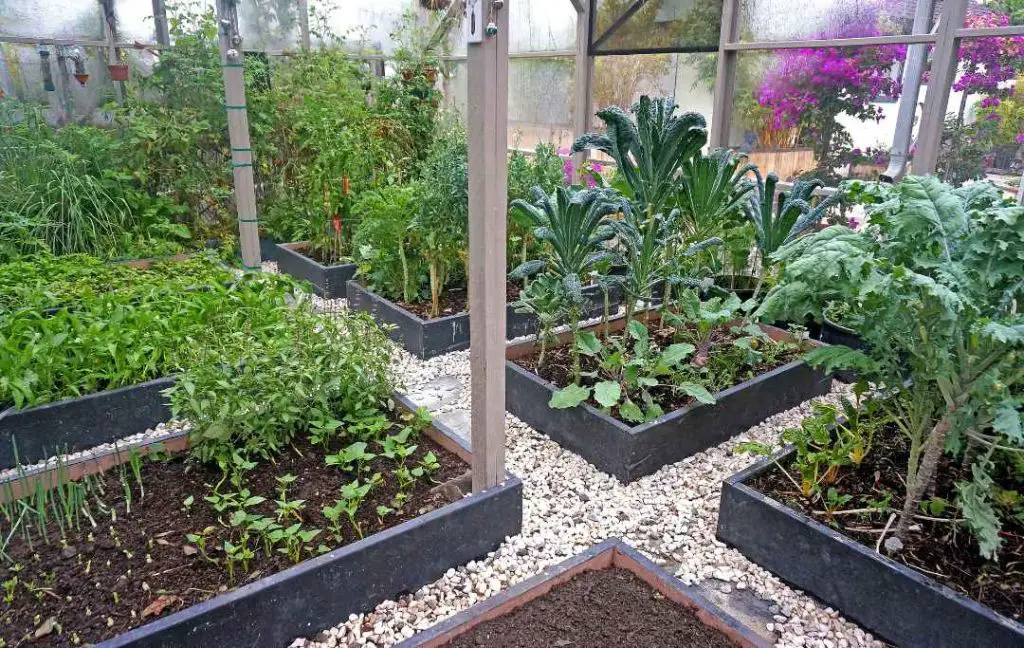
You can maintain the fertility of the soil which is not possible when you grow plants in traditional ground beds. Heavy clay soil Or poor soil is very compacted and your plants will not thrive well in that condition. Those who are facing back problems should prefer raised bed gardening.
The soil in the raised bed warms quickly so you can start your growing season earlier. Light and nutrient-rich soil are filled in raised beds to get double yield. The size of the raised bed is such that you can easily access your plants and maintain them.
The most important benefit of raised beds is that you can grow many plants close together in a 4 feet wide bed. You will get a more bountiful harvest. Before planning schemes for raised beds, you should know which plants are suitable for companion planting.
What Can You Plant Together In A Raised Bed?
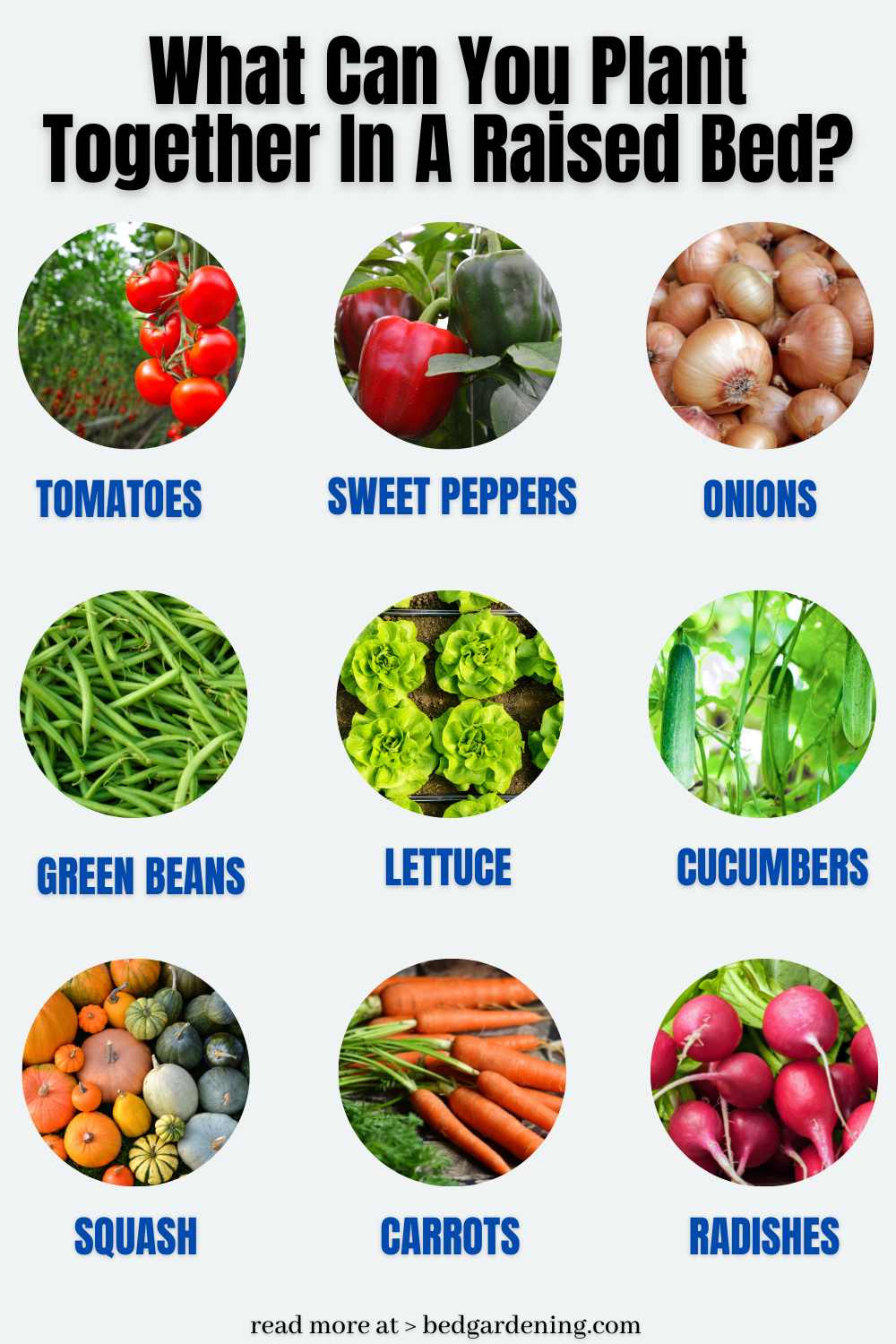
The following are some raised bed vegetable garden layout plans for growing different vegetables. We will discuss with you different vegetables one by one that can grow with other vegetables.
1- TOMATOES
You should select basil for growing with tomatoes because it helps to repel flies and mosquitoes and increase the production of tomatoes.
Marigolds are also ideal partners because they prevent tomato plants from nematodes and other pests. If we talk about more companions of tomato plants they are celery, carrots, asparagus, lettuce, onion, parsley, and spinach.
2- SWEET PEPPERS
Sweet peppers are also included in our list. Like tomato plants, basil also helps to prevent sweet pepper plants from spider mites, mosquitoes, aphids, and flies.
Basil also helps to improve the flavor of sweet peppers. The Other companion plants of sweet peppers are tomatoes, spinach, and onions.
3- ONIONS
It is better to plant carrots near onions because they repel carrot flies. The Other companion plants with onions are tomatoes, parsnips, carrots, cabbage, lettuce, and beets.
4- GREEN BEANS
Corns and beans have a friendly relationship and they nicely grow together in raised beds. If you grow beans with corn then there is no need to install proper support in the raised bed.
Because beans easily train on the thin corn plants. Beans can fix nitrogen in the soil so they help corn grow. The other companion plants of green beans are marigolds, rosemary, cucumbers, Brussels sprouts, potatoes, radishes, and nasturtiums.
5- LETTUCE
If you want to prevent your lettuce plants from slugs then you should plant mint among lettuce. Chives and garlic also help keep aphids away. The other companion plants for letters are marigolds, peas, beets, beans, broccoli, carrots called, and radishes.
6- CUCUMBERS
If you want to protect your cucumber plants from aphids and beetles then you should plant marigolds and nasturtiums along with them. Other companion plants are corn, lettuce, peas, beans, and radishes.
7- SQUASH
The perfect companion plant of squash is corn. Call stocks provide support to squash Vines. The other ideal companion plants are radishes, beans, marigolds, and peas.
8- CARROTS
Carrots are deep-rooted plants so you must build raised beds so their roots have enough space. Tomato plants are ideal companion plants for carrots.
Tomatoes produce natural pesticide solanine that is very effective against pests. On the other hand, carrots are also beneficial for tomatoes because they aerate the soil in a raised bed. Air and water are very important factors for the growth of tomato plants.
Carrots and leeks are also wonderful companions because carrots can repel carrot flies. Leeks also repel onion flies and leek moths. You can also grow rosemary sage and chai with carrots.
9- RADISHES
Cucumbers and carrots are ideal companions for radishes. Radishes are picked before the carrots. That’s why they soften the soil for the carrots’ harvest. The other best companions are lettuce, spinach, squash, kale, beets, and cabbage.
10- SWEET CORN
Sweet corn has friendly relations with green beans. Green beans can fix nitrogen in the soil and corn stalks provide proper support for green beans. The other companion plants for sweetcorn are cucumbers, zucchini, pumpkins, peas, melons, and beans.
How Do You Arrange Plants In Raised Bed?
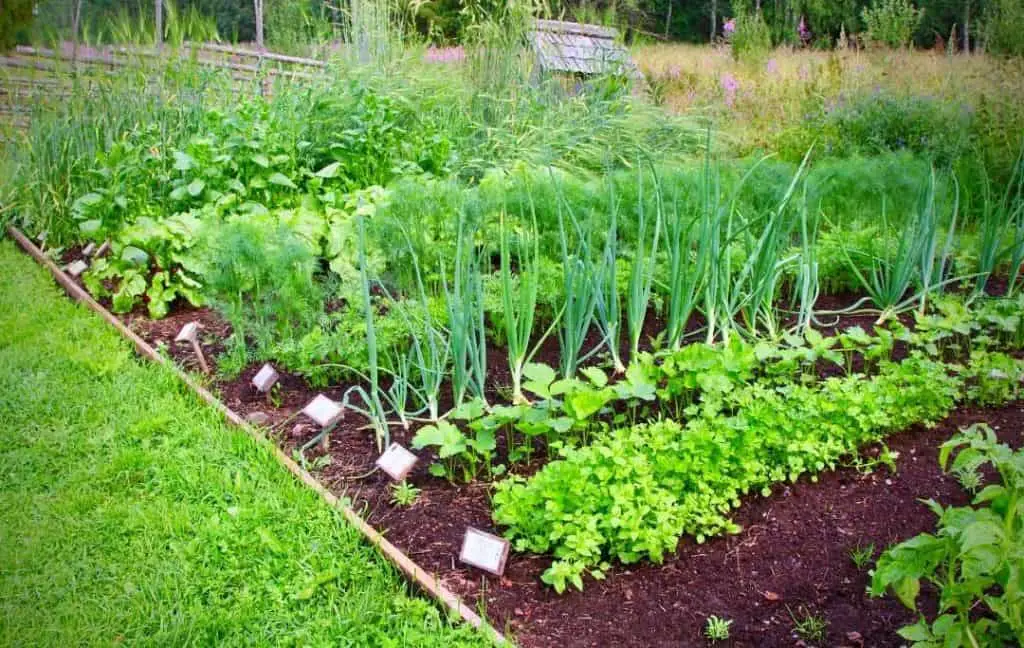
For raised bed gardening, you have to do some research before starting planting. Following are some factors that you must keep in your mind.
LOCATION
The location of your raised bed is very important because most plants thrive well in direct sunlight for most of the day. A sunny location received 6 to 8 hours of sunlight. Raised garden beds can be placed anywhere in your garden or yard.
Besides sunlight, you should also care about wind protection. Neighboring plants or fences can provide protection to your plants. The location you choose for your raised bed must be near the water source.
PICK MEASUREMENTS APPROPRIATE FOR YOUR CROPS
The raised beds are elevated and their height is very beneficial. The height of the raised bed varies from 12 to 20 inches from the ground. Even the wheelchair user can easily maintain their plant without facing any trouble.
You can fill raised beds with light soil that’s why your plants grow quickly and healthier. The length of the race but according to the area you have. But the maximum width of the raised bed must be 3 feet.
If your raised bed is wider than 3 feet then you can’t maintain your plants easily. The plants in the middle of the raised bed will be neglected.
USE THE RIGHT MATERIAL FOR YOUR RAISED BED
Raised beds can be built using materials such as concrete, timber, metal, and plastic. Most people built their raised beds from wood. For building a raised bed, you must use water and rot-resistant wood such as redwood and cedar.
USE THE RIGHT SOIL
If the soil of your garden is poor and it contains clay or sand then you must not use it for filling your raised bed. It is better to buy a high-quality potting mix because it contains all the essential nutrients that are good for the healthier growth of your plants.
The addition of compost and fertilizers will make your soil richer. The potting mix you are using must contain all the organic material according to the plants you choose for your raised bed. Professional potting soil is designed for growing different fruits and vegetables.
ARRANGE PLANTS ACCORDING TO THEIR HEIGHT
You should plant your plants according to their height in your raised bed. This should not happen at the time of harvesting, you can’t reach your short plants due to tall plants.
Taller plants such as okra or corn should be planted along the raised bed middle line. The most suitable place for medium-height plants is in your raised bed on either side. The edge of the raised bed is the best place for planting the shortest plants such as carrots and radishes.
FERTILIZE YOUR PLANTS REGULARLY
After building a raised bed, fill it with the right soil and plant the right variety of plants. Now is the time to feed your plants so that the roots of the plants absorb nutrients and thrive quickly.
You can use slow-release garden fertilizer to fasten the growth of your plants. You will get all the suggestions and instructions in the packet. you should not ignore the instructions and follow them.
WHAT VEGETABLES GROW BEST IN RAISED BED?
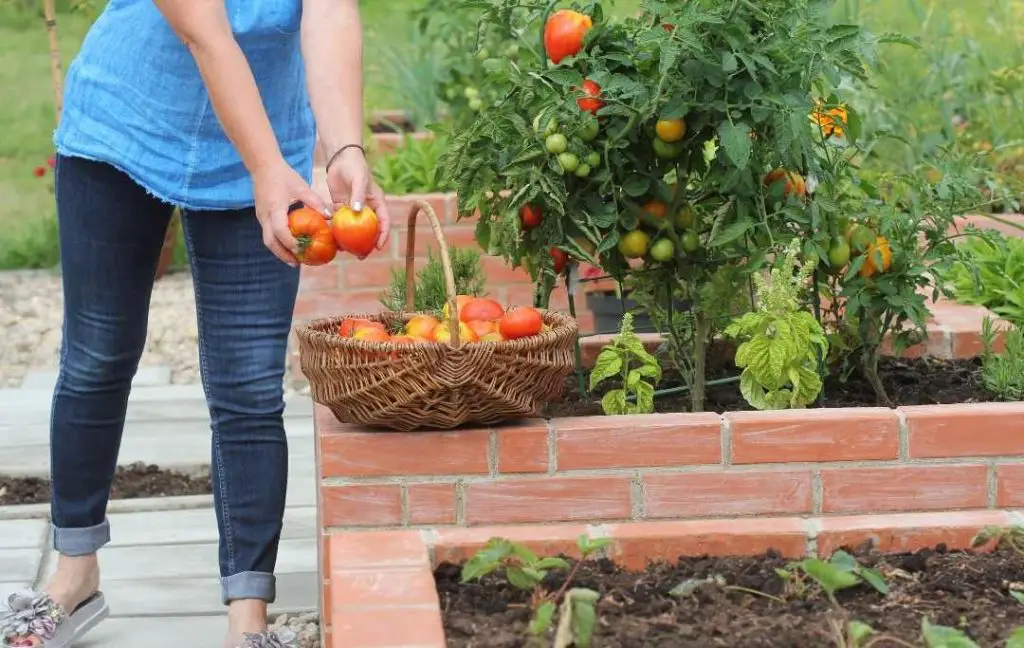
Now we will discuss with you what type of vegetables grow best in your raised bed so you can easily select.
ROOT VEGETABLES
Root vegetables such as radishes, carrots, turnips, beets, and parsnips can grow well in loose and rock-free soil. Fertile and rich soil is needed for the growth of rooted vegetables so you should be careful before filling your raised bed.
If you use garden soil for filling your raised bed and it has rocks then the roots of the vegetables cannot easily spread in the soil and you will not get your desired yield.
LEAFY GREENS
You can choose leafy vegetables such as spinach, lettuce, and kale for your raised bed. These crops are likely to grow in a cold climate.
The soil of the raised bed warms up quickly so you can start your growing season earlier. You should maintain the frequency of water and avoid overwatering because leafy greens don’t like wet feet.
ONIONS
Onions need well-drained soil with rich organic content. If you are growing onions from seed then after a hundred days you can harvest them.
TOMATOES
Your soil must be rich in nutrients because tomatoes are heavy feeders. You must amend your soil by adding extra compost so tomato plants can easily adjust in your raised bed.
Tomato plants need proper support so you have to install tomato cages so your fruit will not be damaged. There are many advantages to support. Your plants will get proper air and harvesting will become easier.
POTATOES
Lose loamy and well-drained soil is needed by potatoes. Potatoes spread in the soil so your soil must be loose so they can thrive easily without rotting. When you grow plants in your raised bed you can maintain the fertility of the soil.
The control over the soil makes gardening easier for you. When you use high-quality potting mix for growing your potato plants then you will get large tubers and higher yield.
Best Flowering Plants For Raised Bed
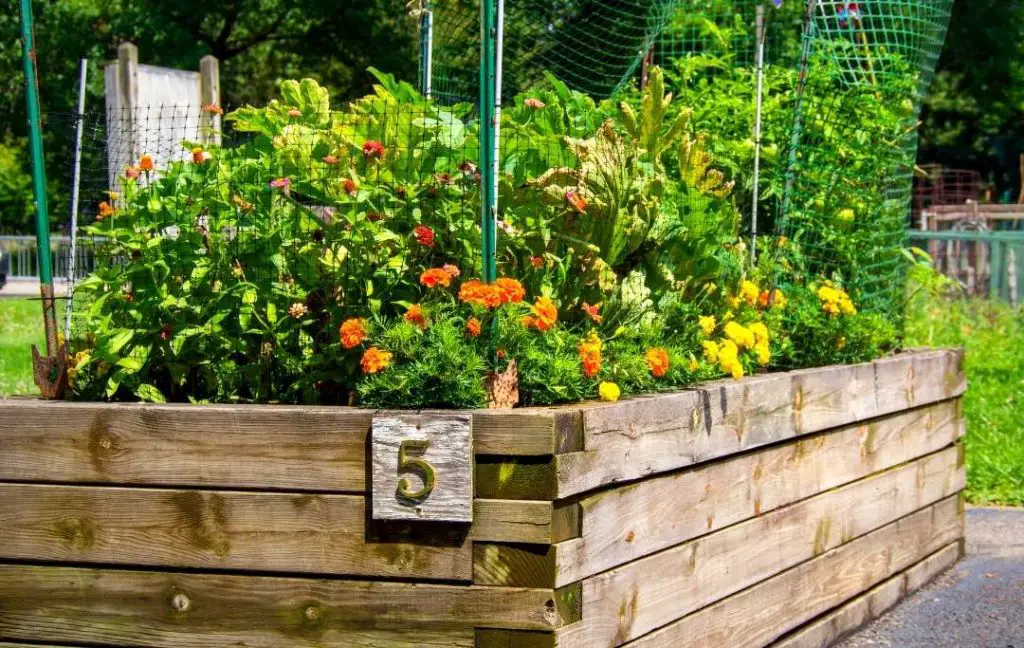
The flowering plants you select for your raised bed must add visual interest. The flowering plants you pick for your raised bed must be good for your vegetables. Following is a list of flowers that can flourish well in your raised bed.
CONEFLOWERS
Cornflowers attract pollinators such as birds and bees. The height of cornflour plants can be about 6 feet. The best time to plant the seeds is in spring or fall.
SUNFLOWERS
The attractive sunflowers are drought and heat-resistant. They attract birds and bees. You can easily grow sunflowers in your raised beds for a large pot. But the location must be sunny because they can grow well in full sun.
ZINNIAS
Zinnias are found in different colors and they can grow up to 2 feet. These flowers are also attractive to pollinators.
MARIGOLD
This is a mosquito-repellent plant so you can easily grow it on your patio or balcony. The ideal location for growing it is around your house.
NASTURTIUM
This flower comes in yellow, red, orange, and Ivory shades. The maximum height of the nasturtium can be 10 feet. The flowers and leaves of this plant are edible.
LAVENDER
A Fully sunny location is needed for your raised bed for growing lavender. The flowers of lavender plants come in purple, white, and pink shades. This plant is also attractive to bees and butterflies. The other quality of the lavender plant is it keeps mosquitoes away.
MORNING GLORIES
Morning glories come in pink, purple, white, red, and blue shades. The height of this plant can be 15 feet. When you grow morning glories, your raised bed will become the center of attraction in your garden.
